
There exists a poignant contrast in the canine world: larger dogs, like the towering Bernese mountain dogs and Great Danes, often have significantly shorter lifespans compared to smaller breeds such as corgis and Pomeranians. This disparity, a result of selective breeding, might soon lessen thanks to groundbreaking research.
Loyal, a San Francisco-based biotech startup, is developing an experimental drug that aims to both extend lifespan and improve quality of life in large dog breeds. Recently, the FDA signaled a vote of confidence that the company’s drug has a “reasonable expectation of effectiveness.”
To be clear, this doesn’t mean that the FDA is saying that the drug works. It simply means that based on preliminary data, the FDA is okay with having the drug tested in a more extensive trial.
Loyal’s drug, designed for administration every three to six months, targets the IGF-1 hormone, linked to growth, metabolism, and, ultimately, canine size. IGF-1’s influence is not limited to dogs. Its manipulation has shown life-extension effects in smaller organisms like worms and flies. It’s also critically important in human development.
Alongside human growth hormone (HGH), IGF-1 is essential for a child to meet growth milestones and achieve normal height. However, the balance is delicate; in humans, both excessively high and low levels can increase mortality risk.
In some dogs, the concentration of IGF-1 is out of whack. From chihuahuas to mastiffs, dogs differ more in size than any other mammal species on the planet. It’s all due to a mutation in the IGF1 gene, first flagged by scientists more than 15 years ago.
Dogs were domesticated from wolves sometime in the past 30,000 years. However, it’s only recently — in the past 200 years or so — that the current extreme size differences appeared as a result of humans becoming increasingly involved in the establishment of new breeds. This explains why today the largest breeds are up to 40 times larger than the smallest.
However, this excessive selective breeding has caused a lot of trouble in many breeds. The lack of genetic diversity among purebreds can increase the risk of inherited diseases like cancer and blindness. In very large breeds, such as Great Danes and English mastiffs, the life expectancy is around 7-8 years according to a 2020 study. For comparison, the average dog lives for 10 to 13 years.
Loyal’s early studies have been promising, according to WIRED. Their trials with 130 dogs demonstrated a reduction in IGF-1 levels without significant side effects, save for minor digestive disturbances in two cases. Now that the FDA has given the go-ahead, the next step is to test this drug more extensively.
The true test of efficacy will come with a larger trial slated for the mid-2020s, involving around 1,000 elderly large and giant breed dogs. Success here could lead to conditional FDA approval, a significant step toward market availability. Parallel to this, Loyal is also developing alternative drug forms and extending their research to encompass dogs of all sizes.
Caution and Hope
Still, as with any experimental science, caution remains paramount. While IGF-1 is a known factor in canine size and longevity, its sole influence is yet to be definitively proven. Another gene, ERBB4, has also been implicated in canine longevity, suggesting a complex interplay of genetic factors.
It’s also worth noting that since the whole purpose of this drug is to enhance longevity, assessing the effectiveness of the treatment will take a long time — think years.
But for many loving dog owners, the wait may be worth it if it means spending more days with their pet. Moreover, this research extends beyond canine welfare. Some aspects of canine genetics may transcend to the human genome, meaning there may be some overlap that could lead to new treatments for humans.









